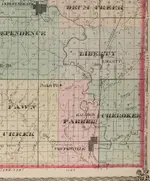The story of the Daltons stashing their loot before the Coffeyville job makes no sense, really. It would make no sense at all to stash a cache of loot less than 3 miles from where you plan on robbing a bank, and likely attempting to escape a posse. the various stories told by witnesses, and by Emmett Dalton himself, do not jive, so no real determination can be made as to what route the Gang used to enter Coffeyville.
Some stories state the Gang "camped on Onion Creek "near where it joins the Verdigris [River]". On the 1878 map below, Onion Creek can be seen coming down from the west from Fawn Creek Township (Sect 15), then passing to the southeast of Coffeyville, into Indian Territory (OK), where it joins the Verdigris about a 1/4 mile south of the border (below Sect 18 of Cherokee Twp.). The location of the two banks in Coffeyville is very near where the railroad tracks coming from the north intersects the meridian line near the center of the town's cross-hatching.
Several witnesses, testifying at Emmett's trial soon after the Coffeyville Raid, stated they saw a group of 5 heavily-armed horsemen (some said 6) enter town on Eighth Street from the west. They assumed the group was a U.S. Marshall and deputies headed for Indian Territory. (on the map, 8th St corresponds with the heavier meridian line just above the "Osage Diminished Reserve" line).
In Emmett's two books that he wrote ("Beyond the Law" & "When the Daltons Rode"), he reminisced about "riding past his family's old home" which is located at the extreme south edge of Coffeyville (512 Kansas Street, and still standing) , just above the "fork" in the railroad tracks on the map.
The story of Mary Brown hearing riders talking from "under a bridge over Onion Creek" is not clear as to which of the several Onion Creek Bridges this was. At that time there were five, that I can find. One was southwest of town, just under the "LL" of "Coffeyville" on the map, two others due west of town (near the "CO", and "E") another one farther west of town, in Fawn Creek Twp (Sect 25) and another due south of town about 100 yards north of the Border (Parker, Sect 13; the road was built after this map was drawn).
Another account tells of "the afternoon of October 4, 1892, a group of men cut a barbed wire fence and rode their horses across a plowed field, five abreast, to some timber near Onion Creek on a farm located three miles southwest of Coffeyville. They tied their horses to separate trees and prepared to camp." The account further states that the next morning, they "...followed their tracks back over the plowed field to the bank of Onion Creek, where the bridge crossed the stream, then headed north to the trail known as Coffeyville’s Eighth Street. Here they turned east..."
Everything is open to interpretation, of course. Most evidence seems to indicate the Dalton Gang DID NOT stash any loot anywhere around Coffeyville.
For those interested, the map shown was drawn in 1878, 7 years after Coffeyville was incorporated (founded in 1869), and 14 years before the attempted bank robberies.. To correspond with modern maps, the meridian line passing through town east-to-west "roughly" corresponds to today's highway U.S. 166. Today, U.S. Highway 169 comes from the south, (crossing Onion Creek, but not the Verdigris R.) then angles slightly east on it's way north, crossing the Verdigris right about where the river crosses Sects 30 and 31 in Cherokee Twp., passing about 2 miles east of the town of Liberty. The "Osage Diminished Reserve" Line is the original, mis-surveyed southern border of Kansas, 2.5 miles north of where the actual border with Oklahoma is now. This is also why there is a "step" in the city limits shown on the map. This line roughly corresponds with today's 13th Street in Coffeyville.


